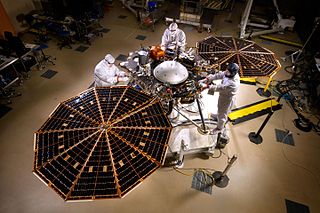Payload is the carrying capacity of an aircraft or launch vehicle, usually measured in terms of weight. Depending on the nature of the flight or mission, the payload of a vehicle may include cargo, passengers, flight crew, munitions, scientific instruments or experiments, or other equipment. Extra fuel, when optionally carried, is also considered part of the payload. In a commercial context, payload may refer only to revenue-generating cargo or paying passengers.

The Centaur is a family of rocket stages. They are designed to be the upper stage of space launch vehicles and is used on the Atlas V. Centaur was the world's first high-energy upper stage, burning liquid hydrogen (LH2) and liquid oxygen (LOX). Centaur has enabled the launch of some of NASA's most important scientific missions during its 50-year history.

The SM-65 Atlas was the first operational intercontinental ballistic missile (ICBM) developed by the United States and the first member of the Atlas rocket family. It was built for the U.S. Air Force by Convair Division of General Dynamics at the Kearny Mesa assembly plant north of San Diego. Atlas became operational as an ICBM in October 1959 and was used as a first stage for satellite launch vehicles for half a century. The Atlas missile's warhead was over 100 times more powerful than the bomb dropped over Nagasaki in 1945.
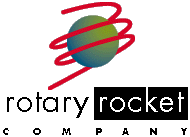
Rotary Rocket Company was a rocketry company that developed the Roton concept in the late 1990s as a fully reusable single-stage-to-orbit (SSTO) manned spacecraft. The design was initially conceived by Gary Hudson, who formed the company to commercialize the concept. The Roton was intended to reduce costs of launching payloads into low earth orbit by a factor of ten.

Skylon is a series of designs for a single-stage-to-orbit spaceplane by the British company Reaction Engines Limited (REL), using SABRE, a combined-cycle, air-breathing rocket propulsion system. The vehicle design is for a hydrogen-fuelled aircraft that would take off from a purpose-built runway, and accelerate to Mach 5.4 at 26 kilometres altitude using the atmosphere's oxygen before switching the engines to use the internal liquid oxygen (LOX) supply to take it into orbit. It could carry 17 tonnes of cargo to an equatorial low Earth orbit (LEO); up to 11 tonnes to the International Space Station, almost 45% more than the capacity of the European Space Agency's Automated Transfer Vehicle; or 7.3 tonnes; 7,300 kilograms (16,000 lb) to Geosynchronous Transfer Orbit (GTO), over 24% more than SpaceX F9 RTLS The relatively light vehicle would then re-enter the atmosphere and land on a runway, being protected from the conditions of re-entry by a ceramic composite skin. When on the ground, it would undergo inspection and necessary maintenance, with a turnaround time of approximately two days, and be able to complete at least 200 orbital flights per vehicle.

The Saturn IB was an American launch vehicle commissioned by the National Aeronautics and Space Administration (NASA) for the Apollo program. It replaced the S-IV second stage of the Saturn I with the much more powerful S-IVB, able to launch a partially fueled Apollo command and service module (CSM) or a fully fueled lunar module (LM) into low Earth orbit for early flight tests before the larger Saturn V needed for lunar flight was ready.

The Lockheed Martin X-33 was an unmanned, sub-scale technology demonstrator suborbital spaceplane developed in the 1990s under the U.S. government-funded Space Launch Initiative program. The X-33 was a technology demonstrator for the VentureStar orbital spaceplane, which was planned to be a next-generation, commercially operated reusable launch vehicle. The X-33 would flight-test a range of technologies that NASA believed it needed for single-stage-to-orbit reusable launch vehicles, such as metallic thermal protection systems, composite cryogenic fuel tanks for liquid hydrogen, the aerospike engine, autonomous (unmanned) flight control, rapid flight turn-around times through streamlined operations, and its lifting body aerodynamics.
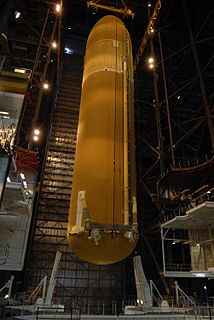
The Space Shuttle external tank (ET) was the component of the Space Shuttle launch vehicle that contained the liquid hydrogen fuel and liquid oxygen oxidizer. During lift-off and ascent it supplied the fuel and oxidizer under pressure to the three Space Shuttle Main Engines (SSME) in the orbiter. The ET was jettisoned just over 10 seconds after MECO, where the SSMEs were shut down, and re-entered the Earth's atmosphere. Unlike the Solid Rocket Boosters, external tanks were not re-used. They broke up before impact in the Indian Ocean, away from shipping lanes and were not recovered.

Titan IIIB was the collective name for a number of derivatives of the Titan II ICBM and Titan III launch vehicle, modified by the addition of an Agena upper stage. It consisted of four separate rockets. The Titan 23B was a basic Titan II with an Agena upper stage, and the Titan 24B was the same concept, but using the slightly enlarged Titan IIIM rocket as the base. The Titan 33B was a Titan 23B with the Agena enclosed in an enlarged fairing, in order to allow larger payloads to be launched. The final member of the Titan IIIB family was the Titan 34B which was a Titan 24B with the larger fairing used on the Titan 33B.

Atlas II was a member of the Atlas family of launch vehicles, which evolved from the successful Atlas missile program of the 1950s. It was designed to launch payloads into low earth orbit, geosynchronous transfer orbit or geosynchronous orbit. Sixty-three launches of the Atlas II, IIA and IIAS models were carried out between 1991 and 2004; all sixty-three launches were successes, making the Atlas II the most reliable launch system in history. The Atlas line was continued by the Atlas III, used between 2000 and 2005, and the Atlas V which is still in use.

A launch vehicle or carrier rocket is a rocket used to carry a payload from Earth's surface through outer space, either to another surface point, or into space. A launch system includes the launch vehicle, launch pad, vehicle assembly and fuelling systems, range safety, and other related infrastructure.

The Saturn II was a series of American expendable launch vehicles, studied by North American Aviation under NASA contract in 1966, derived from the Saturn V rocket used for the Apollo lunar program. The intent of the study was to eliminate production of the Saturn IB, and create a lower-cost heavy launch vehicle based on Saturn V hardware. North American studied three versions with the S-IC first stage removed: the INT-17, a two-stage vehicle with a low Earth orbit payload capability of 47,000 pounds (21,000 kg); the INT-18, which added Titan UA1204 or UA1207 strap-on solid rocket boosters, with payloads ranging from 47,000 pounds (21,000 kg) to 146,400 pounds (66,400 kg); and the INT-19, using solid boosters derived from the Minuteman missile first stage.
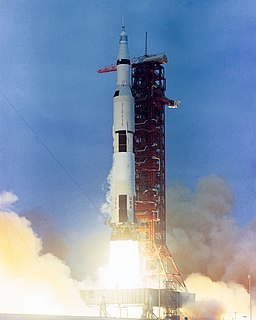
The Saturn V was an American human-rated expendable rocket used by NASA between 1967 and 1973. The three-stage liquid-propellant super heavy-lift launch vehicle was developed to support the Apollo program for human exploration of the Moon and was later used to launch Skylab, the first American space station.
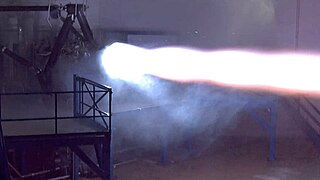
Raptor is a staged combustion, methane-fueled rocket engine under development by SpaceX. The engines are powered by cryogenic liquid methane and liquid oxygen (LOX), rather than the RP-1 kerosene and LOX used in all previous SpaceX Falcon rockets which use or used Merlin 1A, 1C, & 1D and Kestrel engines. The earliest concepts for Raptor considered liquid hydrogen as fuel rather than methane. The Raptor engine will have about two times the thrust of the Merlin 1D engine that powers the current Falcon 9 launch vehicle.
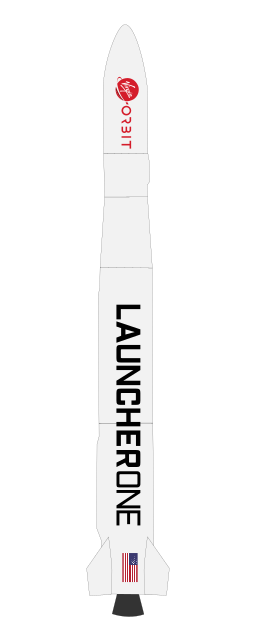
LauncherOne is a two stage orbital launch vehicle under development by Virgin Orbit since 2007. It is an air launch to orbit rocket, designed to launch "smallsat" payloads of 300 kilograms (660 lb) into Sun-synchronous orbit, following air launch from a carrier aircraft at high altitude. Launches are projected to begin in early 2019.
Pegasus II, also known as Thunderbolt, was an air-launched orbital rocket under development in 2012–2015 by Orbital Sciences Corporation for use by Stratolaunch Systems.

The ITS launch vehicle was a 2016-2017 design for a privately funded orbital launch vehicle planned to be developed by SpaceX. Design work was discontinued in 2017 when development was shifted to a smaller version, now called BFR. The initial design objective of the ITS launch vehicle was to launch a variety of SpaceX Interplanetary Transport System missions to Mars and other destinations in the beyond-Earth-orbit portion of the Solar System. The first launch was not expected before the 2020s.

Cygnus CRS OA-6, also known as Orbital ATK CRS-6, is the sixth flight of the Orbital ATK unmanned resupply spacecraft Cygnus and its fifth flight to the International Space Station under the Commercial Resupply Services contract with NASA.
The New Glenn is a heavy-lift orbital launch vehicle in development by Blue Origin. Design work on the vehicle began in 2012. The vehicle itself, and the high-level specifications, were initially publicly unveiled in September 2016. New Glenn is described as a two-stage rocket with a diameter of 7 meters (23 ft). Its first stage will be powered by seven BE-4 engines that are also being designed and manufactured by Blue Origin.

The Big Falcon Rocket is a privately-funded, fully-reusable launch vehicle and spacecraft system in development by SpaceX. In November 2018 the second stage and ship was renamed by Elon Musk to Starship, while the first stage was given the moniker "Super Heavy". The overall space vehicle architecture includes both launch vehicle and spacecraft, as well as ground infrastructure for rapid launch and relaunch, and zero-gravity propellant transfer technology to be deployed in low Earth orbit (LEO). The payload capacity to Earth orbit of at least 100,000 kg (220,000 lb) makes BFR a super heavy-lift launch vehicle. However, if the pattern seen in previous iterations holds, the full Starship-Super Heavy stack could be capable of launching 150 tons or more to low earth orbit, more than any other launch vehicle currently planned. The first orbital flight is tentatively planned for 2020.



